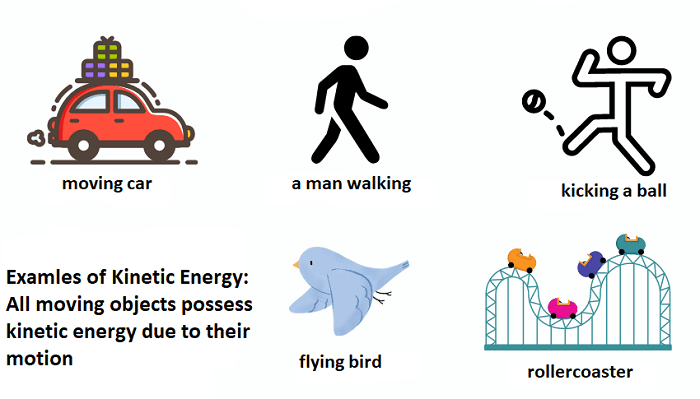What is Kinetic Energy?The energy possessed by an object due to its motion in any direction (horizontal or vertical) is known as kinetic energy. In simple words, we can say that it is the energy of motion. So, every moving object around us possesses kinetic energy. Further, the kinetic energy of an object is due to the net work done on it as no object can move and cover the distance without applying a force on it. 
Formula of Kinetic EnergyThe formula of kinetic energy shows the relation of energy with mass (m) and velocity (v). The kinetic energy of an object of mass 'm' moving with velocity 'v' is given by Kinetic energy = ½ mv2 m = mass of the object in motion v = speed of the object So, the kinetic energy of an object can be calculated as half its mass times the square of its velocity (v). Kinetic Energy is a scalar quantity so it does not depend on the direction and thus its value will always be positive. As we know energy is the capacity to do work and kinetic energy is also a type of energy, so the above formula of kinetic energy is the expression of the fact that a moving object has kinetic energy that can do work on anything it hits. The above formula tells the amount of work a moving object can do as a result of its motion. The above formula also shows that K.E is directly proportional to the mass and square of the velocity of the object. So, if we double the mass, the energy will get doubled and if we double the velocity, it will be four times the previous value. For example, a moving truck at twice the speed will have four times the kinetic energy. For example, a truck moving at 50 kmph will have four times the kinetic energy of the same truck moving at 25 kmph. So, a large truck will have more kinetic energy than a small truck and will cause more damage when it hits something. Kinetic energy can be transferred from one object to the other or between objects. Further, it can be transformed into other types of energy. For example, if a moving car collides with a stationary object then some of the kinetic energy of the car gets transferred to the object or transformed into another type of energy. Kinetic Energy UnitsThe SI unit of kinetic energy is the joule (J), which is equal to 1 kg.m2.s-2. It is also a type of energy and the unit of energy in the metre-kilogram-second system is the joule. For example, a 2 kg object moving at a speed of 1 m/s will have a kinetic energy of 1 joule. As per the centimetre-gram-second system, the unit of energy is the erg, 10-7 joule, which is equal to the kinetic energy of a mosquito flying in the air. Facts about Kinetic Energy
Deriving Kinetic Energy Equation or FormulaThe kinetic energy equation or formula can be derived from the work done (w) by a force (f) on an object. For example, a body of mass 'm' is pushed by applying force 'f' and it covers a distance 'd' on a surface, this the work done on the object makes it move and due to movement it possesses kinetic energy, so work done in this case, is equal to kinetic energy or can be used to derive kinetic energy equation. W = F. d (force . displacement ) Now f = m . a ( mass . acceleration) So, after putting the value of f, we have W = m . a . d ( mass x acceleration x displacement) As per the third equation of motion, the acceleration is given by; a = v2 - u2/ 2d v = final velocity of object u= initial velocity of object d = displacement now, after putting the value of a, we have; W = m. d. v2 -u2 / 2d W = m . v2 -u2 /2 Let the initial velocity 'u' is zero, as the object was at rest before force is applied to it. So, on simplifying the above equation, we get; W = m . v2 /2 or ½ mv2 As work done is equal to kinetic energy, so, we get; KE = ½ mv2 From the above equation, it is clear that the total work done on a system or an object is equal to the change in kinetic energy if it starts moving. So, Wnet = ∆ K (net work done = change in kinetic energy) Solved Examples:1. Find the kinetic energy of a 100 kg object moving at a speed of 10 m/s. Solution: K.E can be calculated using the following equation: KE = ½ mv2 KE = ½ (100 kg) (10 m/s) 2 = 50 x 100 = 5000 J Similarly, if we know the kinetic energy and velocity of speed, we can calculate the mass of the object as shown in the below-solved example; 2. Find the mass of a car travelling at a speed of 50 m/s and has a kinetic energy of 2000 J. Solution: KE = ½ mv2 After rearranging the above equation, we get m = 2KE/v2 After substituting the given values, we get m = 2 x 2000 / 502 = 1.6 Kg Similarly, we can calculate the speed of an object if we know its mass and kinetic energy as shown in the below-solved example; 3. A 500 kg boat has a kinetic energy of 2000 J. Calculate the speed at which it is moving? Solution: KE = ½ mv2 After rearranging, we get V2 = 2 KE /m V2 = 2 x 2000 / 500 = 2.8 m/s Examples / Uses of kinetic energy
Next TopicPotential Energy
|
 For Videos Join Our Youtube Channel: Join Now
For Videos Join Our Youtube Channel: Join Now
Feedback
- Send your Feedback to [email protected]
Help Others, Please Share









